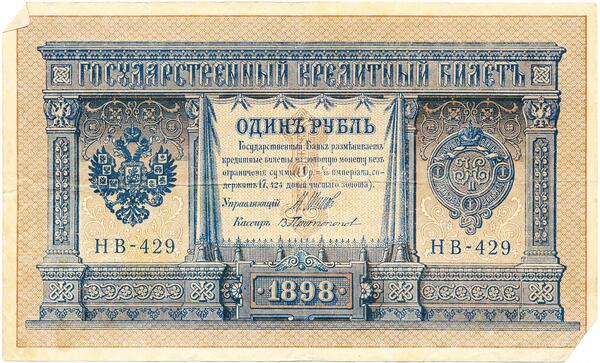In 1810, Alexander I issued a manifesto on the cessation of the issue and compulsory redemption of the assignat rubles that were in circulation: the state was trying to curb inflation. Paper money was to be burnt right in front of the State Bank building so that the population could see the money stock shrink. The same manifesto also referred to the silver ruble as the monetary basis.
In 1839 the Manifesto “On the Organization of the Monetary System” was issued. Finance Minister Egor Frantsevich Kankrin conducted a reform which resulted in the recognition of the silver ruble as the main means of payment. Since then, all state taxes and duties were paid only in silver.
In 1843, assignat rubles were officially replaced by state banknotes at a rate of 3.5:1. The appearance of the new banknotes changed and improved. In 1866 the first portraits of Russia’s rulers appeared on paper money: Dmitry Donskoy, Mikhail Fedorovich, Aleksey Mikhailovich, Peter the Great and Catherine the Great.
At the end of the 19th century, Finance Minister Sergey Witte proposed the introduction of a gold standard, following the example of developed European countries. This helped prevent the depreciation of paper money and put more gold into circulation, which had previously been given a secondary role.
Among the exhibits of the Volgograd Museum of Local History there are dozens of banknotes of one ruble denomination of the time of Emperor Nicholas II. On the front side there was a large inscription “State credit note”, a small state emblem of 1883, as well as a monogram of Nicholas II.
On this side there was also an inscription: “The State Bank shall exchange banknotes for gold coins without any amount limitation (1 ruble = 1/15th of an imperial, contains 17,424 fractions of pure gold)”. The signatures of the manager and the cashier were placed below.
On the reverse side on the left was a denomination in big letters, in the middle — a small coat of arms of the state and on the right side — three clauses from the decree: “1. The exchange of the State credit notes for gold coins is guaranteed by all the assets of the state. 2. State credit notes shall be circulated throughout the empire on the same basis as gold coins. 3. For forgery of credit notes the guilty are liable to deprivation of all rights of estate and exile for hard labor.
In 1839 the Manifesto “On the Organization of the Monetary System” was issued. Finance Minister Egor Frantsevich Kankrin conducted a reform which resulted in the recognition of the silver ruble as the main means of payment. Since then, all state taxes and duties were paid only in silver.
In 1843, assignat rubles were officially replaced by state banknotes at a rate of 3.5:1. The appearance of the new banknotes changed and improved. In 1866 the first portraits of Russia’s rulers appeared on paper money: Dmitry Donskoy, Mikhail Fedorovich, Aleksey Mikhailovich, Peter the Great and Catherine the Great.
At the end of the 19th century, Finance Minister Sergey Witte proposed the introduction of a gold standard, following the example of developed European countries. This helped prevent the depreciation of paper money and put more gold into circulation, which had previously been given a secondary role.
Among the exhibits of the Volgograd Museum of Local History there are dozens of banknotes of one ruble denomination of the time of Emperor Nicholas II. On the front side there was a large inscription “State credit note”, a small state emblem of 1883, as well as a monogram of Nicholas II.
On this side there was also an inscription: “The State Bank shall exchange banknotes for gold coins without any amount limitation (1 ruble = 1/15th of an imperial, contains 17,424 fractions of pure gold)”. The signatures of the manager and the cashier were placed below.
On the reverse side on the left was a denomination in big letters, in the middle — a small coat of arms of the state and on the right side — three clauses from the decree: “1. The exchange of the State credit notes for gold coins is guaranteed by all the assets of the state. 2. State credit notes shall be circulated throughout the empire on the same basis as gold coins. 3. For forgery of credit notes the guilty are liable to deprivation of all rights of estate and exile for hard labor.



